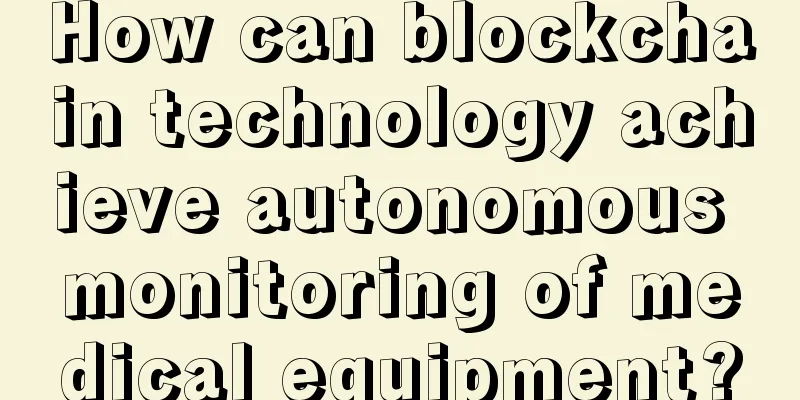How can blockchain technology achieve autonomous monitoring of medical equipment?

|
It’s time to move away from theoretical results and start doing some practical research to explore how blockchain technology can be used to achieve autonomous monitoring of medical devices. The National Institute of Standards and Technology (NIST) and the Office of the National Coordinator for Health Information (ONC) have collaborated to launch a request for proposals titled "ONC Blockchain Challenge." They invited leaders in healthcare and network technology to submit research papers on the topic of "Blockchain applications for health IT and health-related research." Jeff Brandt, an expert in communications, security, and healthcare, and I have submitted a proposal titled “Co-Creating Healthcare Trust: A Crypto-Civic Architecture for Blockchain Interoperability.” The proposal proposes research propositions to address future technologies, and Brandt and I have identified three main areas that require further research, including medical device monitoring. Ubiquitous Autonomous Monitoring of Medical Devices The stability of blockchain can improve the possibility of access to medical information. How will medical services change in the next 3 to 10 years? Will the definition of treatment change? Today, we have the idea of preventive medicine and face-to-face appointments with doctors. Tomorrow, robots and machines may become part of the new definition of preventive medicine. In this paper, Brandt and I argue that blockchain is already being used in the maintenance of medical devices and can enable the free flow of devices between institutions. Distributed sharing of devices will create new markets for semi-autonomous devices. For example, delivery robots can autonomously deliver medical supplies, disinfection robots can interact with people who have been diagnosed with infectious diseases, and the information of these devices will be passed to other devices without reporting to central control devices. Medical nanotechnology has the potential to use nanorobots to inject through patients' cells. Special ingestibles and wearable devices for monitoring the heart are just the beginning of digital tools with broadband capabilities to enter the market, such as "smart" drugs that can monitor the internal reactions of drugs in the human body. This shows that medical nanotechnology is just getting started. Using blockchain to monitor atrial fibrillation To further illustrate our research proposition, we will give an example of how blockchain is used in medical equipment maintenance: Here is an example of how blockchain technology can be used to manage medical devices. Patient John has signs of atrial fibrillation and has an implanted atrial defibrillator device. This implantable defibrillator uses low-energy shocks to quickly restore heart rhythm. The defibrillator is manufactured by company "X" with serial number "Y". During the manufacturing process, blockchain technology will be used to track the device. The U.S. Food and Drug Administration (FDA) requires that a hashed unique device identifier (UDI) be stored on the blockchain along with other relevant information. The hash of the device information is stored and verified in an immutable digital ledger. The device will be assigned to John (the patient) and the blockchain of this device will already have updates on the hospital, doctor, emergency contact information, advance directives, etc., which will enable John to be better cared for. The defibrillator has a series of smart contracts on it that can automatically notify the patient or the device supplier when the device battery fails or the patient becomes unhealthy. Today, preventive maintenance of equipment is essential. For example, when a defibrillator needs maintenance, it will sound an alarm to the patient. Smart contracts will also send preventive maintenance information to patients and equipment providers to reduce the occurrence of disasters. The arguments Brandt and I have developed offer new avenues for exploration, but more research is needed. These avenues have identified three areas that require further investigation: Proposition 1: From medical devices to nanomachines, they are all within the scope of medical equipment maintenance, and they will achieve autonomous communication between devices. Proposition 2: Individual and public self-sovereignty and related identity information should be placed in the hands of patients. Proposition 3: Electronic health information exchange (HIE) and claims database (APCD) will use blockchain technology to establish a trust platform. Blockchain technology will contribute to the interoperability of healthcare. However, the solution to this national crisis is purely to add another layer of technology. Potential payer and device program issues will require a more complete patient-centric solution. Ownership of patient data accelerates the transparency of health information data. Blockchain technology can monitor detailed data access records, such as data accessors and data access periods. Individuals will also provide sovereignty, security and privacy information to protect the interests of patients or organizations, while also reducing risks, enhancing security and monitoring accuracy, and enabling relevant organizations to conduct strict authority control, saving a lot of time. Our paper, “Co-creating Healthcare Trust: A Crypto-Civic Architecture for Blockchain Interoperability,” is available for download at ResearchGate.net. NIST and ONC will announce the results of the blockchain challenge on August 29. We believe blockchain technology can inspire the public to co-create healthcare trust. |
<<: Decentralized semi-autonomous platform Synereo is moving forward with alpha development
>>: Why do we need decentralized social networks?
Recommend
ttt
Preparation First, back up or download the driver...
How to tell a person's personality from their forehead
The forehead refers to the area between the hairl...
Horizon Labs Co-Founder: CBDCs Could Increase Awareness of Bitcoin
In 2020, central bank digital currencies have gai...
Why do squares appear on the fate line? What are the effects?
The fate line is a line that shows the rise and f...
How to tell if a man has good fortune?
For men, wealth is not only the capital of self-c...
Illustration of fortune telling based on zygomatic bone
The zygomatic bone is located in the middle of th...
How long can the 21 Inc Bitcoin computer's micropayment story last?
The much-anticipated 21 Bitcoin computer has been...
How is the fate of a person with a rebellious bone on the back of his head?
From a medical point of view, the bones in the hu...
Analysis of the six facial features of villains
A person's character and inner qualities are o...
Fan-ear facial features
Fan-eared people lose money Characteristics of fa...
The first Bitcoin transnational network pyramid scheme case was cracked, with the amount involved exceeding 40 billion yuan
Recently, according to the deployment of the Mini...
Solana Strategy Director: Solana’s Token Scaling Plan
Token extensions are a feature on the Solana bloc...
As the end of the year approaches, the reasons and implications of the Antminer S9's continued survival
With the recent surge in the price of Bitcoin, ma...
The founder of Gongxinbao, a high-risk cryptocurrency community, was convicted of opening a casino and responded by claiming he was implicated.
(Correction: Because the original title "Thr...
Santander and UBS discuss blockchain technology at Bank of England Open Forum meeting
Swiss investment bank UBS and Spanish bank Santan...









